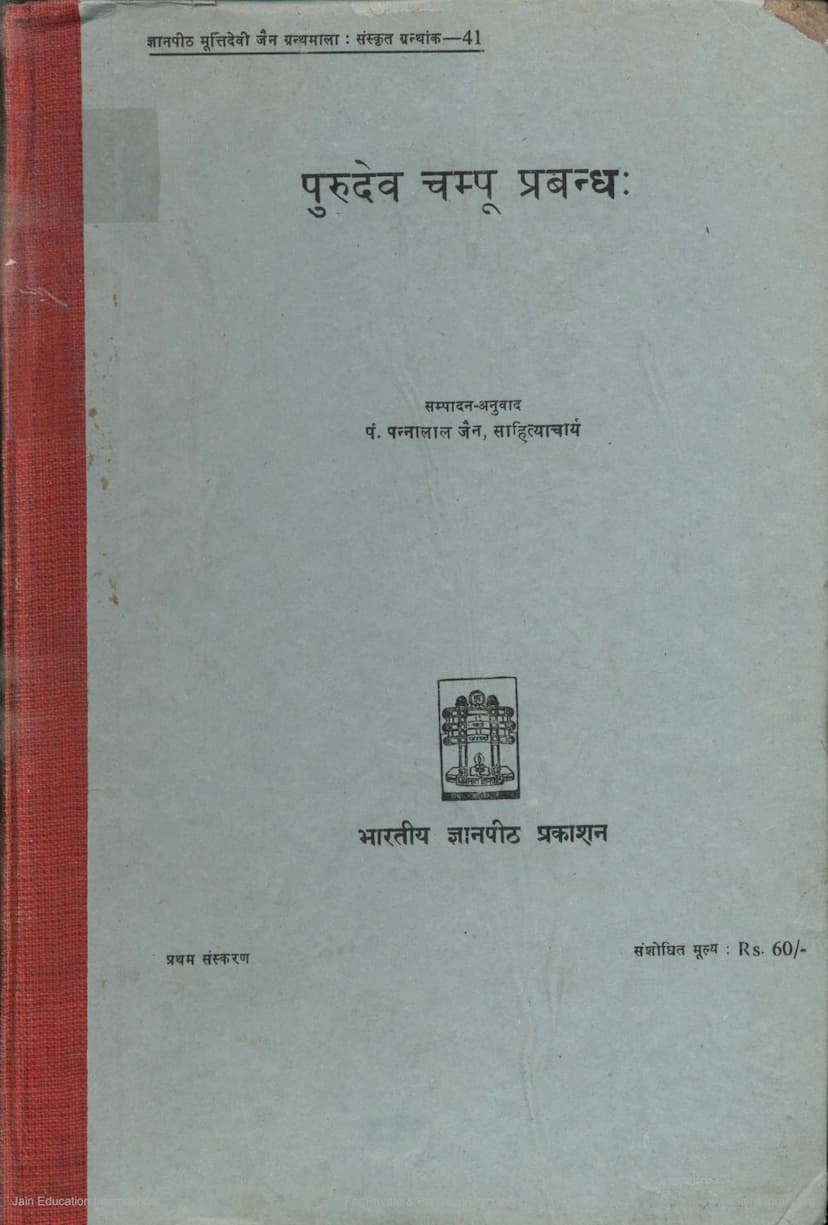Purudev Champoo Prabandh
Added to library: September 2, 2025

Summary
The "Purudev Champū Prabandh" by Arhaddas, edited and translated by Pannalal Jain and published by Bharatiya Gyanpith, is a Sanskrit work that tells the story of Purudev, who is identified as the first Jain Tirthankara, Rishabhanatha (also known as Adinath). This summary is based on the provided text, which appears to be an introduction and a table of contents for the book.
Here's a breakdown of the key aspects:
Book Title and Authorship:
- Title: Purudev Champū Prabandh (पुरुदेव चम्पू प्रबन्ध)
- Author: Mahakavi Shrimad Arhaddasa (महाकवि श्रीमदर्हद्दास)
- Editor & Translator: Pandit Pannalal Jain, Sahityacharya (पण्डित पन्नालाल जैन, साहित्याचार्य)
- Publisher: Bharatiya Gyanpitha (भारतीय ज्ञानपीठ)
- Publication Details: This is the first edition, published in Vira Samvat 2498, Vikram Samvat 2029, corresponding to 1972 AD. The price for the first edition was Rs. 21/.
Gyanpith Murti Devi Jain Granthamala:
- The book is part of the "Gyanpith Murti Devi Jain Granthamala," Sanskrit Grantha No. 41.
- This series, founded by Sahu Shantiprasad Jain in memory of his mother Shrimati Murti Devi, aims to research, critically edit, and publish Jain Agamic, philosophical, Pauranic, literary, historical, and other original texts.
- The texts are published in their original languages (Prakrit, Sanskrit, Apabhramsha, Hindi, Kannada, Tamil, etc.) and with translations in modern languages.
- The series also includes catalogues of Jain Bhandaras, inscriptions, and studies by scholars.
Genre and Style:
- The book is a "Champū kāvya" (चम्पू काव्य), a literary genre that combines prose (गद्य) and poetry (पद्य) in a single work. The origin of the term "Champū" is noted as a mystery, with no clear etymological derivation from Sanskrit roots.
- The text is praised for its artistic prose and poetry, comparable to works by classical Sanskrit authors like Banabhatta and Subandhu in prose, and Bharavi, Magha, and Shri Harsha in poetry.
- The author, Arhaddasa, is described as having exceptional talent, and his work is noted for its elaborate use of samāsas (compound words) and śleṣa (puns) and other figures of speech (alaṅkāras), which can make it challenging to fully grasp the rasa and bhava (sentiment and emotion).
Subject Matter:
- The central theme of the Purudev Champū Prabandh is the life and character of the first Jain Tirthankara, Rishabhanatha, also known as Purudev or Adhinath.
- The text covers his previous lives (bhavāntara), detailing ten of them as outlined in the Adipurāṇa by Acharya Jinasena. These previous lives are described as essential for understanding the spiritual journey and the path to achieving the highest spiritual state (which leads to becoming an Ishvara in Jain philosophy).
- The narrative then proceeds to the life of Rishabhanatha himself, his birth, his role in establishing societal order by teaching six essential functions (military, writing, agriculture, music/dance, craftsmanship, and trade), his marriage, his renunciation of worldly life, his tapasya (ascetic practices), attainment of Kevala Jñana (omniscience), his teachings, his nirvana (liberation), and the story of his eldest son, Bharata, the first Chakravarti (universal emperor), and his brother Bahubali.
Key Features and Significance:
- Literary Excellence: Arhaddasa's poetry is described as "chatttering, tender, beautiful word-collections, extremely bright with letters," which is found to be true upon review.
- Influence and Impact: The text is considered a significant contribution to Jain literature, particularly in the Champū kāvya tradition. It is noted that Jain poets have significantly developed this literary branch.
- Inter-faith Connections: The text highlights that the story of Purudev (Rishabhanatha) has mentions not only in Jain literature but also in Vedic literature, with some descriptions in Vedic Purāṇas aligning with Jain beliefs. However, a caution is advised against hastily equating every mention of "Vṛṣabha" or similar terms in Vedic texts with the Tirthankara, as the word also has meanings like "bull" and "best."
- Commentary: Pandit Pannalal Jain's contribution includes a clear Sanskrit commentary (Vāsanṭī) and a Hindi translation, making the complex text more accessible to a wider audience.
Structure and Content (as per Table of Contents): The book is divided into ten stanzas (stobaka).
- First three stanzas: Describe the previous births (bhavāntara) of Lord Adhinath, following the account in the Adipurāṇa. These sections are noted to be more like Purāṇas in narrative style but are presented with poetic embellishments.
- Fourth stanza onwards: Detail the life of Lord Rishabhanatha, his birth, his establishment of the karma-bhūmi (era of action), his teachings, and the stories of his sons Bharata and Bahubali. The text also covers the naming of Rishabhanatha as Purudev and mentions his connection to Vedic accounts.
Thematic Focus:
- The text emphasizes the exemplary life and teachings of the first Tirthankara, highlighting his role in establishing societal structures and his spiritual journey.
- The introduction also delves into the history and evolution of Champū kāvya, placing Arhaddasa's work within this literary tradition.
In essence, the "Purudev Champū Prabandh" is a significant literary and religious work that provides a detailed and artistically rendered account of the life of the first Jain Tirthankara, making it a valuable resource for understanding both Jain history and Sanskrit literature. Pandit Pannalal Jain's scholarly work in editing, translating, and commenting on the text further enhances its importance and accessibility.